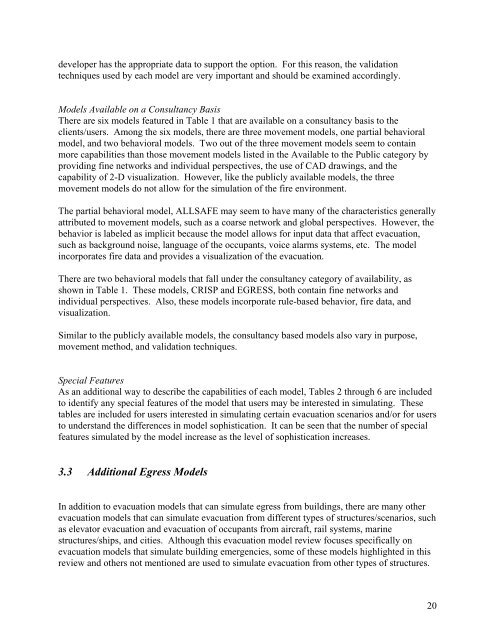A Review of Building Evacuation Models - NIST Virtual Library
A Review of Building Evacuation Models - NIST Virtual Library
A Review of Building Evacuation Models - NIST Virtual Library
Create successful ePaper yourself
Turn your PDF publications into a flip-book with our unique Google optimized e-Paper software.
developer has the appropriate data to support the option. For this reason, the validation<br />
techniques used by each model are very important and should be examined accordingly.<br />
<strong>Models</strong> Available on a Consultancy Basis<br />
There are six models featured in Table 1 that are available on a consultancy basis to the<br />
clients/users. Among the six models, there are three movement models, one partial behavioral<br />
model, and two behavioral models. Two out <strong>of</strong> the three movement models seem to contain<br />
more capabilities than those movement models listed in the Available to the Public category by<br />
providing fine networks and individual perspectives, the use <strong>of</strong> CAD drawings, and the<br />
capability <strong>of</strong> 2-D visualization. However, like the publicly available models, the three<br />
movement models do not allow for the simulation <strong>of</strong> the fire environment.<br />
The partial behavioral model, ALLSAFE may seem to have many <strong>of</strong> the characteristics generally<br />
attributed to movement models, such as a coarse network and global perspectives. However, the<br />
behavior is labeled as implicit because the model allows for input data that affect evacuation,<br />
such as background noise, language <strong>of</strong> the occupants, voice alarms systems, etc. The model<br />
incorporates fire data and provides a visualization <strong>of</strong> the evacuation.<br />
There are two behavioral models that fall under the consultancy category <strong>of</strong> availability, as<br />
shown in Table 1. These models, CRISP and EGRESS, both contain fine networks and<br />
individual perspectives. Also, these models incorporate rule-based behavior, fire data, and<br />
visualization.<br />
Similar to the publicly available models, the consultancy based models also vary in purpose,<br />
movement method, and validation techniques.<br />
Special Features<br />
As an additional way to describe the capabilities <strong>of</strong> each model, Tables 2 through 6 are included<br />
to identify any special features <strong>of</strong> the model that users may be interested in simulating. These<br />
tables are included for users interested in simulating certain evacuation scenarios and/or for users<br />
to understand the differences in model sophistication. It can be seen that the number <strong>of</strong> special<br />
features simulated by the model increase as the level <strong>of</strong> sophistication increases.<br />
3.3 Additional Egress <strong>Models</strong><br />
In addition to evacuation models that can simulate egress from buildings, there are many other<br />
evacuation models that can simulate evacuation from different types <strong>of</strong> structures/scenarios, such<br />
as elevator evacuation and evacuation <strong>of</strong> occupants from aircraft, rail systems, marine<br />
structures/ships, and cities. Although this evacuation model review focuses specifically on<br />
evacuation models that simulate building emergencies, some <strong>of</strong> these models highlighted in this<br />
review and others not mentioned are used to simulate evacuation from other types <strong>of</strong> structures.<br />
20
















